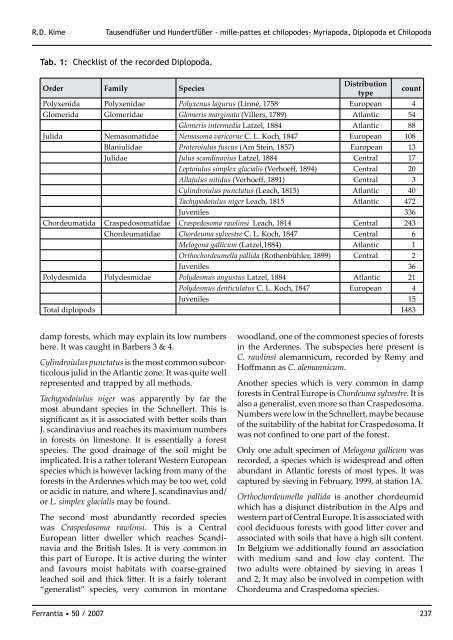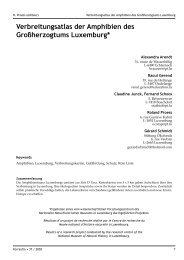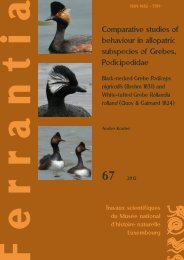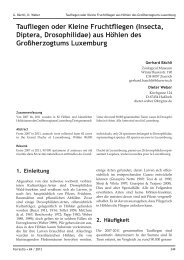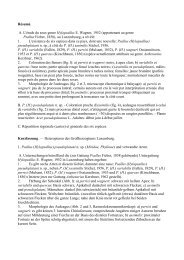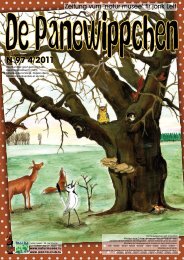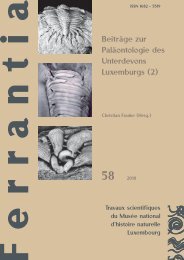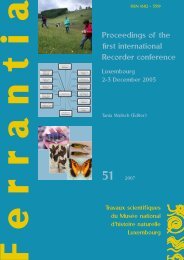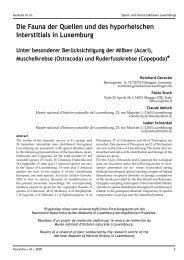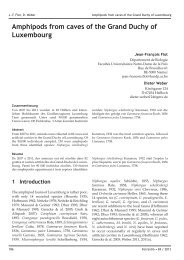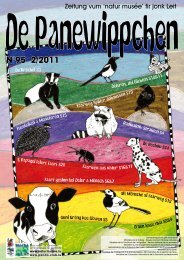- Seite 1 und 2:
Inventaire de la biodiversité dans
- Seite 3 und 4:
Ferrantia 50 Inventaire de la biodi
- Seite 5 und 6:
Beintastler - protoures - Protura 2
- Seite 7 und 8:
M. Meyer, E. Carrières Biodiversit
- Seite 9 und 10:
M. Meyer Introduction De 1997 à 20
- Seite 11 und 12:
M. Meyer Les organismes étudiés e
- Seite 13 und 14:
EFOR Ingénieurs-Conseils Höhere P
- Seite 15 und 16:
EFOR Ingénieurs-Conseils Höhere P
- Seite 17 und 18:
M. T. Tholl, G. Marson, B. Schulthe
- Seite 19 und 20:
M. T. Tholl, G. Marson, B. Schulthe
- Seite 21 und 22:
M. T. Tholl, G. Marson, B. Schulthe
- Seite 23 und 24:
M. T. Tholl, G. Marson, B. Schulthe
- Seite 25 und 26:
M. T. Tholl, G. Marson, B. Schulthe
- Seite 27 und 28:
J. Werner & F. Hans Moosflora - flo
- Seite 29 und 30:
J. Werner & F. Hans Moosflora - flo
- Seite 31 und 32:
J. Werner & F. Hans Moosflora - flo
- Seite 33 und 34:
J. Werner & F. Hans Moosflora - flo
- Seite 35 und 36:
J. Werner & F. Hans Moosflora - flo
- Seite 37 und 38:
J. Werner & F. Hans Moosflora - flo
- Seite 39 und 40:
Y. Krippel Farne - fougères - Pter
- Seite 41 und 42:
Y. Krippel Farne - fougères - Pter
- Seite 43 und 44:
Y. Krippel Farne - fougères - Pter
- Seite 45 und 46:
L. Bock Profils pédologques Profil
- Seite 47 und 48:
L. Bock Profils pédologques FICHE
- Seite 49 und 50:
L. Bock Profils pédologques Tablea
- Seite 51 und 52:
L. Bock Profils pédologques Tablea
- Seite 53 und 54:
L. Bock Profils pédologques La fai
- Seite 55 und 56:
L. Bock Profils pédologques Commen
- Seite 57 und 58:
L. Bock Profils pédologques Tablea
- Seite 59 und 60:
L. Bock Profils pédologques FICHE
- Seite 61 und 62:
L. Bock Profils pédologques Tablea
- Seite 63 und 64:
L. Bock Profils pédologques Tablea
- Seite 65 und 66:
L. Bock Profils pédologques Deleco
- Seite 67 und 68:
L. Beck, J. Römbke, F. Meyer, J. S
- Seite 69 und 70:
L. Beck, J. Römbke, F. Meyer, J. S
- Seite 71 und 72:
L. Beck, J. Römbke, F. Meyer, J. S
- Seite 73 und 74:
L. Beck, J. Römbke, F. Meyer, J. S
- Seite 75 und 76:
L. Beck, J. Römbke, F. Meyer, J. S
- Seite 77 und 78:
L. Beck, J. Römbke, F. Meyer, J. S
- Seite 79 und 80:
L. Beck, J. Römbke, F. Meyer, J. S
- Seite 81 und 82:
L. Beck, J. Römbke, F. Meyer, J. S
- Seite 83 und 84:
L. Beck, J. Römbke, F. Meyer, J. S
- Seite 85 und 86:
L. Beck, J. Römbke, F. Meyer, J. S
- Seite 87 und 88:
L. Beck, J. Römbke, F. Meyer, J. S
- Seite 89 und 90:
L. Beck, J. Römbke, F. Meyer, J. S
- Seite 91 und 92:
L. Beck, J. Römbke, F. Meyer, J. S
- Seite 93 und 94:
L. Beck, J. Römbke, F. Meyer, J. S
- Seite 95 und 96:
L. Beck, J. Römbke, F. Meyer, J. S
- Seite 97 und 98:
L. Beck, J. Römbke, F. Meyer, J. S
- Seite 99 und 100:
L. Beck, J. Römbke, F. Meyer, J. S
- Seite 101 und 102:
L. Beck, J. Römbke, F. Meyer, J. S
- Seite 103 und 104:
L. Beck, J. Römbke, F. Meyer, J. S
- Seite 105 und 106:
L. Beck, J. Römbke, F. Meyer, J. S
- Seite 107 und 108:
L. Beck, J. Römbke, F. Meyer, J. S
- Seite 109 und 110:
L. Beck, J. Römbke, F. Meyer, J. S
- Seite 111 und 112:
L. Beck, J. Römbke, F. Meyer, J. S
- Seite 113 und 114:
L. Beck, J. Römbke, F. Meyer, J. S
- Seite 115 und 116:
L. Beck, J. Römbke, F. Meyer, J. S
- Seite 117 und 118:
L. Beck, J. Römbke, F. Meyer, J. S
- Seite 119 und 120:
L. Beck, J. Römbke, F. Meyer, J. S
- Seite 121 und 122:
L. Beck, J. Römbke, F. Meyer, J. S
- Seite 123 und 124:
L. Beck, J. Römbke, F. Meyer, J. S
- Seite 125 und 126:
L. Beck, J. Römbke, F. Meyer, J. S
- Seite 127 und 128:
L. Beck, J. Römbke, F. Meyer, J. S
- Seite 129 und 130:
L. Beck, J. Römbke, F. Meyer, J. S
- Seite 131 und 132:
E. Carrières Métodologie inverté
- Seite 133 und 134:
E. Carrières Métodologie inverté
- Seite 135 und 136:
E. Carrières Métodologie inverté
- Seite 137 und 138:
E. Carrières Métodologie inverté
- Seite 139 und 140:
E. Carrières Métodologie inverté
- Seite 141 und 142:
E. Carrières Métodologie inverté
- Seite 143 und 144:
E. Carrières Métodologie inverté
- Seite 145 und 146:
E. Carrières Métodologie inverté
- Seite 147 und 148:
E. Carrières Métodologie inverté
- Seite 149 und 150:
E. Carrières Métodologie inverté
- Seite 151 und 152:
E. Carrières Métodologie inverté
- Seite 153 und 154:
E. Carrières Métodologie inverté
- Seite 155 und 156:
E. Carrières Métodologie inverté
- Seite 157 und 158:
E. Carrières Métodologie inverté
- Seite 159 und 160:
E. Carrières Métodologie inverté
- Seite 161 und 162:
E. Carrières Métodologie inverté
- Seite 163 und 164:
E. Carrières Métodologie inverté
- Seite 165 und 166:
E. Carrières Métodologie inverté
- Seite 167 und 168:
E. Carrières Métodologie inverté
- Seite 169 und 170:
E. Carrières Métodologie inverté
- Seite 171 und 172:
E. Carrières Métodologie inverté
- Seite 173 und 174:
E. Carrières Métodologie inverté
- Seite 175 und 176:
K. Groh Plattwürmer - planaires -
- Seite 177 und 178:
K. Groh Plattwürmer - planaires -
- Seite 179 und 180:
K. Groh, G. Weitmann Weichtiere - m
- Seite 181 und 182:
K. Groh, G. Weitmann Weichtiere - m
- Seite 183 und 184:
K. Groh, G. Weitmann Weichtiere - m
- Seite 185 und 186: K. Groh, G. Weitmann Weichtiere - m
- Seite 187 und 188: K. Groh, G. Weitmann Weichtiere - m
- Seite 189 und 190: K. Groh, G. Weitmann Weichtiere - m
- Seite 191 und 192: K. Groh, G. Weitmann Weichtiere - m
- Seite 193 und 194: K. Groh, G. Weitmann Weichtiere - m
- Seite 195 und 196: K. Groh, G. Weitmann Weichtiere - m
- Seite 197 und 198: K. Groh, G. Weitmann Weichtiere - m
- Seite 199 und 200: K. Groh, G. Weitmann Weichtiere - m
- Seite 201 und 202: K. Groh, G. Weitmann Weichtiere - m
- Seite 203 und 204: K. Groh, G. Weitmann Weichtiere - m
- Seite 205 und 206: K. Groh Afterskorpione - pseudoscor
- Seite 207 und 208: K. Groh Afterskorpione - pseudoscor
- Seite 209 und 210: Ch. Muster Weberknechte - opilions
- Seite 211 und 212: Ch. Muster Weberknechte - opilions
- Seite 213 und 214: Ch. Muster Weberknechte - opilions
- Seite 215 und 216: Ch. Muster Weberknechte - opilions
- Seite 217 und 218: A. Staudt, M. Kreuels, E. Hermann S
- Seite 219 und 220: A. Staudt, M. Kreuels, E. Hermann S
- Seite 221 und 222: A. Staudt, M. Kreuels, E. Hermann S
- Seite 223 und 224: K. Groh, A. Allspach Flohkrebse und
- Seite 225 und 226: K. Groh, A. Allspach Flohkrebse und
- Seite 227 und 228: K. Groh, A. Allspach Flohkrebse und
- Seite 229 und 230: K. Groh, A. Allspach Flohkrebse und
- Seite 231 und 232: K. Groh, A. Allspach Flohkrebse und
- Seite 233 und 234: K. Groh, A. Allspach Flohkrebse und
- Seite 235: R.D. Kime Tausendfüßer und Hunder
- Seite 239 und 240: R.D. Kime Tausendfüßer und Hunder
- Seite 241 und 242: M. Adler Bärtierchen - tardigrades
- Seite 243 und 244: K. Groh Felsenspringer - archéogna
- Seite 245 und 246: R. Proess Geradflügler - orthoptè
- Seite 247 und 248: R. Proess Geradflügler - orthoptè
- Seite 249 und 250: R. Proess Geradflügler - orthoptè
- Seite 251 und 252: N. Schneider Staubläuse - psocopt
- Seite 253 und 254: N. Schneider Staubläuse - psocopt
- Seite 255 und 256: N. Schneider Staubläuse - psocopt
- Seite 257 und 258: N. Schneider Staubläuse - psocopt
- Seite 259 und 260: L. Reichling Wanzen - punaises - He
- Seite 261 und 262: L. Reichling Wanzen - punaises - He
- Seite 263 und 264: R. zur Strassen Fransenflügler - t
- Seite 265 und 266: R. Gerend, F. Köhler, C. Braunert
- Seite 267 und 268: R. Gerend, F. Köhler, C. Braunert
- Seite 269 und 270: R. Gerend, F. Köhler, C. Braunert
- Seite 271 und 272: R. Gerend, F. Köhler, C. Braunert
- Seite 273 und 274: R. Gerend, F. Köhler, C. Braunert
- Seite 275 und 276: R. Gerend, F. Köhler, C. Braunert
- Seite 277 und 278: R. Gerend, F. Köhler, C. Braunert
- Seite 279 und 280: R. Gerend, F. Köhler, C. Braunert
- Seite 281 und 282: R. Gerend, F. Köhler, C. Braunert
- Seite 283 und 284: R. Gerend, F. Köhler, C. Braunert
- Seite 285 und 286: R. Gerend, F. Köhler, C. Braunert
- Seite 287 und 288:
R. Gerend, F. Köhler, C. Braunert
- Seite 289 und 290:
R. Gerend, F. Köhler, C. Braunert
- Seite 291 und 292:
R. Gerend, F. Köhler, C. Braunert
- Seite 293 und 294:
R. Gerend, F. Köhler, C. Braunert
- Seite 295 und 296:
R. Gerend, F. Köhler, C. Braunert
- Seite 297 und 298:
E. Carrières Scorpionsfliegen - m
- Seite 299 und 300:
E. Carrières Netzflügler - névro
- Seite 301 und 302:
E. Carrières Netzflügler - névro
- Seite 303 und 304:
J.-M. Guinet Pflanzenwespen - symph
- Seite 305 und 306:
J.-M. Guinet Pflanzenwespen - symph
- Seite 307 und 308:
J.-M. Guinet Pflanzenwespen - symph
- Seite 309 und 310:
J.-M. Guinet Pflanzenwespen - symph
- Seite 311 und 312:
J.-M. Guinet Pflanzenwespen - symph
- Seite 313 und 314:
J.-M. Guinet Pflanzenwespen - symph
- Seite 315 und 316:
J.-M. Guinet Pflanzenwespen - symph
- Seite 317 und 318:
J.-M. Guinet Pflanzenwespen - symph
- Seite 319 und 320:
J.-M. Guinet Pflanzenwespen - symph
- Seite 321 und 322:
J.-M. Guinet Pflanzenwespen - symph
- Seite 323 und 324:
J.-M. Guinet Pflanzenwespen - symph
- Seite 325 und 326:
J.-M. Guinet Pflanzenwespen - symph
- Seite 327 und 328:
J.-M. Guinet Pflanzenwespen - symph
- Seite 329 und 330:
J.-M. Guinet Pflanzenwespen - symph
- Seite 331 und 332:
J.-M. Guinet Pflanzenwespen - symph
- Seite 333 und 334:
J.-M. Guinet Pflanzenwespen - symph
- Seite 335 und 336:
K. Groh Ameisen - fourmis - Hymenop
- Seite 337 und 338:
M. Meyer Schmetterlinge - papillons
- Seite 339 und 340:
M. Meyer Schmetterlinge - papillons
- Seite 341 und 342:
M. Meyer Schmetterlinge - papillons
- Seite 343 und 344:
M. Meyer Schmetterlinge - papillons
- Seite 345 und 346:
M. Meyer Schmetterlinge - papillons
- Seite 347 und 348:
M. Meyer Schmetterlinge - papillons
- Seite 349 und 350:
P. Vogtenhuber Schnakenverwandte -
- Seite 351 und 352:
P. Vogtenhuber Schnakenverwandte -
- Seite 353 und 354:
P. Vogtenhuber Schnakenverwandte -
- Seite 355 und 356:
P. Vogtenhuber Schnakenverwandte -
- Seite 357 und 358:
P. Vogtenhuber Schnakenverwandte -
- Seite 359 und 360:
E. Carrières, M. Cardew Diptera, K
- Seite 361 und 362:
E. Carrières, M. Cardew Diptera, K
- Seite 363 und 364:
E. Carrières, M. Cardew Diptera, K
- Seite 365 und 366:
G. Tomasowic Raubfliegen - asilidé
- Seite 367 und 368:
E. Carrières Schwebfliegen - syrph
- Seite 369 und 370:
E. Carrières Schwebfliegen - syrph
- Seite 371 und 372:
E. Carrières Schwebfliegen - syrph
- Seite 373 und 374:
E. Carrières Schwebfliegen - syrph
- Seite 375 und 376:
P. Lorgé Vögel - oiseaux - Aves V
- Seite 377 und 378:
J. Pir Fledermäuse - chauves-souri
- Seite 379 und 380:
J. Pir Fledermäuse - chauves-souri
- Seite 381 und 382:
J. Pir Fledermäuse - chauves-souri
- Seite 383 und 384:
M. Meyer Andere Säugetiere - autre
- Seite 385 und 386:
Ferrantia • 50 / 2007 385
- Seite 387 und 388:
adapted according to the concerned
- Seite 389:
28 Die Moosflora der Kleinen Luxemb


